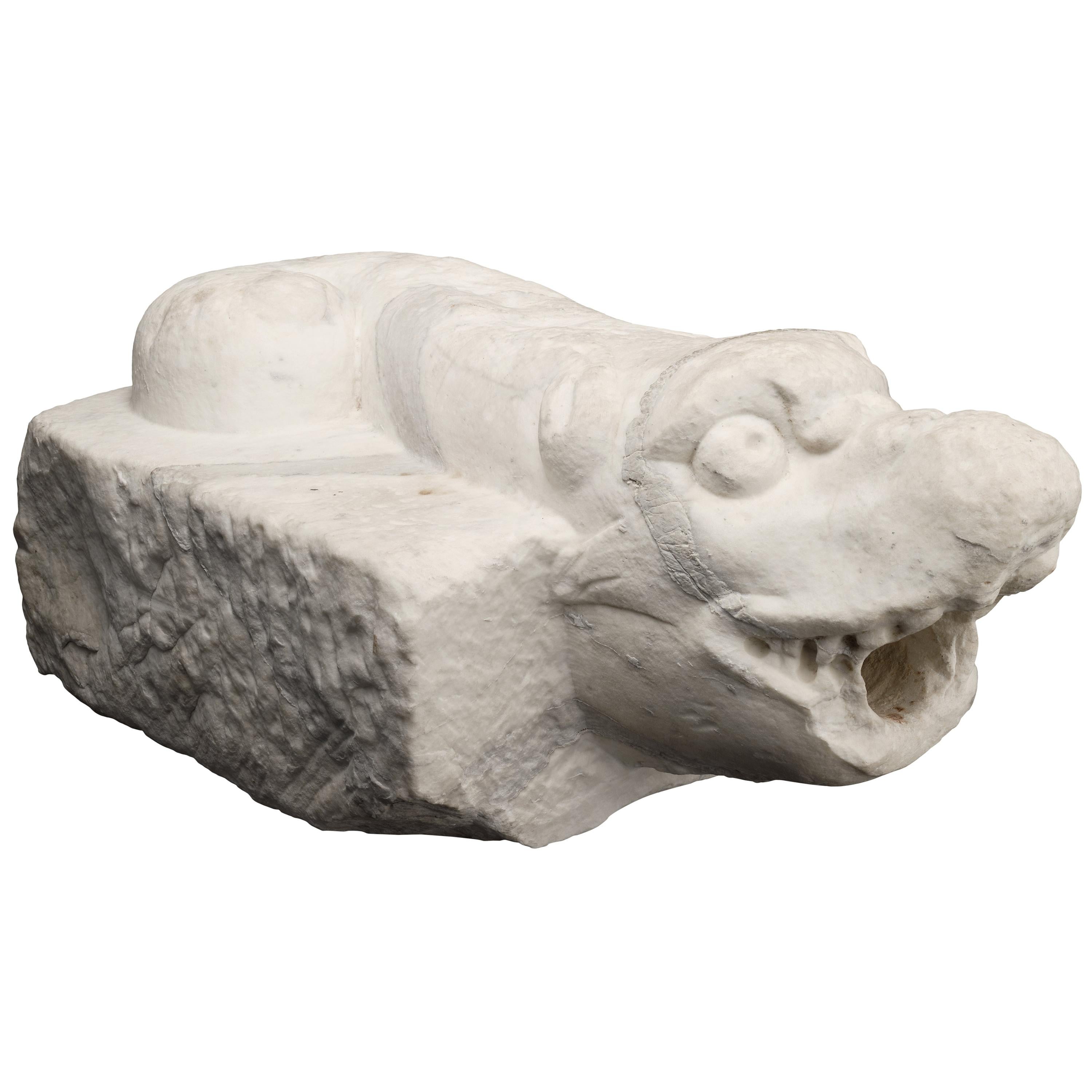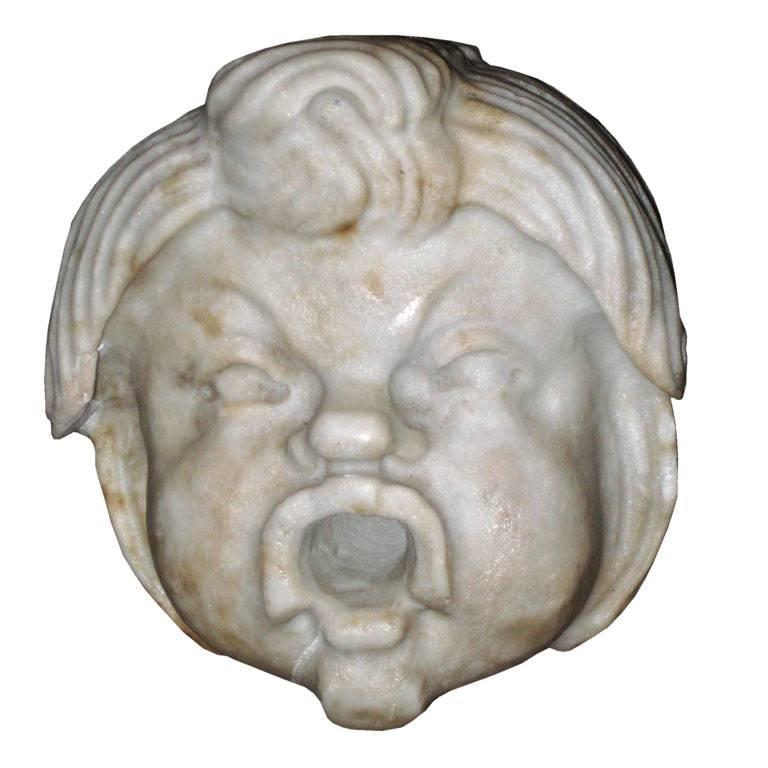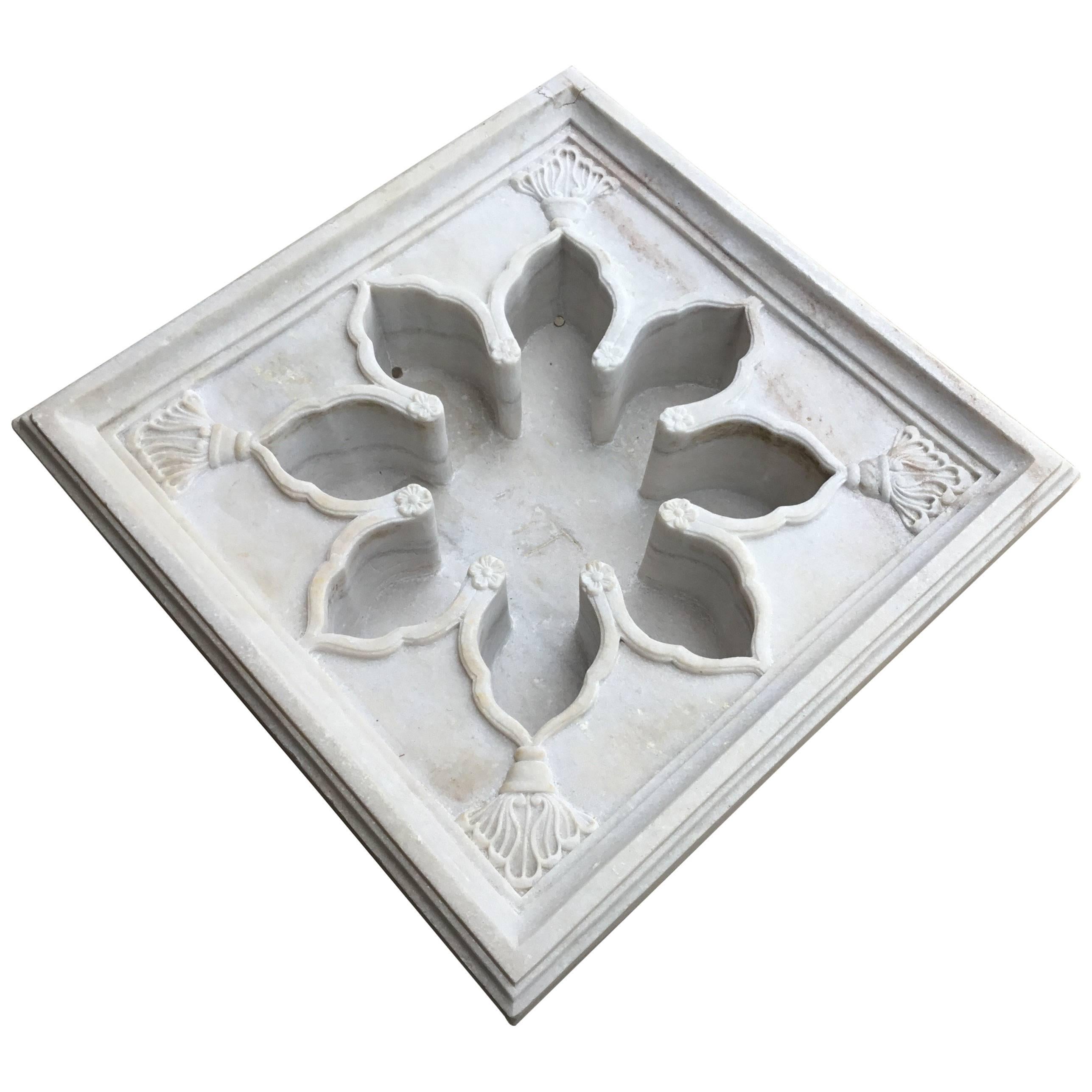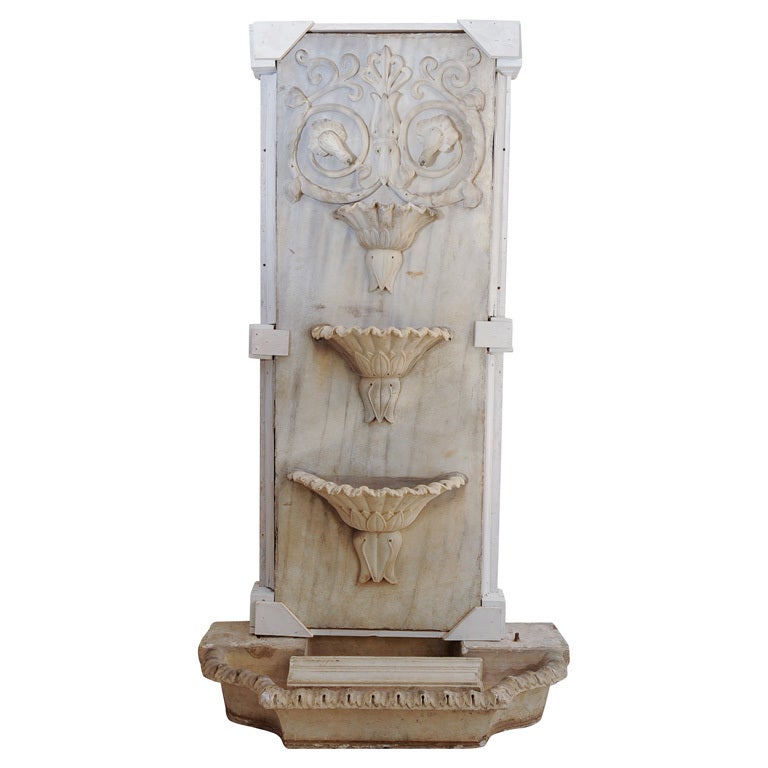Items Similar to 15th or 16th Century Marble Gargoyle Fountain Spout from Arezzo, Italy
Want more images or videos?
Request additional images or videos from the seller
1 of 19
15th or 16th Century Marble Gargoyle Fountain Spout from Arezzo, Italy
About the Item
Although when most people hear the word “gargoyle”, they probably envision small, winged creatures with grotesque visages. However, the phrase has a deeper meaning, encompassing any carved head (animal or human) that function as waterspouts.
From the Early Renaissance (late 1400’s/early 1500’s), our gargoyle fountain spout features a human-like face with pointed ears, possibly representing a centaur or a satyr. The roughly rectangular block of marble was hand-carved in Arezzo, in the Tuscany region of Italy. All sides except the front of the cream-colored stone have a sawed finish, resulting in a rough texture. The back has been excavated, adding to the character of the gargoyle. A 1 ½” diameter hole has been cut all the way through, forming an open mouth of the gargoyle. The gaping mouth was often a symbol used to conjure images of devouring giants and used to remind people that they are susceptible to certain forces.
Our 15th/16th century marble gargoyle would make a great fountain spout for a pre-existing basin. It can be affixed to the side of a building or placed on top of a support, such as a column or pedestal, allowing the water to cascade from the mouth. It can also be displayed inside and appreciated as a rare and extremely old piece of sculptural art.
- Dimensions:Height: 13 in (33.02 cm)Width: 11.25 in (28.58 cm)Depth: 16.25 in (41.28 cm)
- Style:Renaissance (Of the Period)
- Materials and Techniques:
- Place of Origin:
- Period:
- Date of Manufacture:Late 1400s-Early 1500s
- Condition:Wear consistent with age and use. Minor losses. Good antique condition, with wear commensurate to age and use with acceptable losses. Marble is a natural material that can change color with exposure to the elements. Our cream-colored marble has developed a gold/brown patina in some areas.
- Seller Location:Dallas, TX
- Reference Number:
About the Seller
5.0
Platinum Seller
These expertly vetted sellers are 1stDibs' most experienced sellers and are rated highest by our customers.
Established in 1983
1stDibs seller since 2011
736 sales on 1stDibs
Typical response time: <1 hour
- ShippingRetrieving quote...Ships From: Dallas, TX
- Return PolicyA return for this item may be initiated within 2 days of delivery.
More From This SellerView All
- Large Carved Limestone 4-Spout Center Village Fountain from Provence, FranceLocated in Dallas, TXHand-carved in Provence, France, this large center village fountain is comprised of 14 pieces of Estaillade limestone. Each stone has a cream finish with white and gray accents, expe...Category
21st Century and Contemporary French Fountains
MaterialsStone, Limestone, Metal, Iron
- Carved Limestone Fountain Mascaron Spout from the Gard Region of France, 20th CLocated in Dallas, TXHand-carved in the Gard region (a department in the South of France) during the 1900’s, this fountain mascaron spout depicts a heavily bearded man. The face, which has been carved in...Category
20th Century French Fountains
MaterialsStone, Limestone
- Rare 16th Century Architectural Stone Capital from FranceLocated in Dallas, TXThis rare fragment was salvaged from an entryway on a building in Fontvieille, near the city ancient Arles, France. There is a worn and carved center cartouche depicting a very small...Category
Antique 16th Century French Gothic Architectural Elements
MaterialsStone
- 18th Century Carved Limestone Corner Sink or Fountain Basin from Apt, FranceLocated in Dallas, TXThis stone piece was once the basin for a corner fountain or used as corner sink on a property in the rugged hills of Provence, France. It features a thick...Category
Antique 18th Century French Stone Sinks
MaterialsStone, Limestone
- Large Cast Stone Wall Hanging or Fountain Spout of Bacchus, God of WineLocated in Dallas, TXCast in France, using a mixture of pulverized stone and cement, this large wall hanging of Bacchus, God of Wine, can also be used as a fountain spo...Category
21st Century and Contemporary French Neoclassical Wall-mounted Sculptures
MaterialsStone, Cast Stone, Cement
- Antique Bronze Wine Barrel Spout from Saumur, France 19th CenturyLocated in Dallas, TXThis antique bronze wine barrel spout from Saumur, France (with a production mark from “A. Fabre”) dates to the 1800s. Most likely used in a traditional foudre barrel, the spout play...Category
Antique 19th Century French Fountains
MaterialsMetal, Bronze
You May Also Like
- Italian Ancient Marble Sculpture Fountain, Late 16th CenturyLocated in Milano, ITSea monster Carrara marble mouth fountain Italy, late 16th century It measures 13.8 x 31.5 x 18.9 in (35 x 80 x 48 cm) State of conservation: some small evident gaps and widespread signs of wear due to outdoor exposure. The gray marks crossing it do not come from restoration, but are rather the natural veins of the marble. This work has some morphological characteristics typically associated with the iconography of the sea monster: an elongated muzzle, sharp teeth, protruding eyes, elongated ears, and a coiled serpent's tail. An in-depth series of studies on artistic depictions of the sea monster attempted to verify how this symbol evolved in antiquity in the European and Mediterranean contexts and how it gradually changed its image and function over time. The iconography itself is mutable and imaginative and its history is rich with cultural and artistic exchange, as well as the overlapping of ideas. This occurred so much that it is difficult to accurately pinpoint the "types" that satisfactorily represent its various developments. However, we can try to summarize the main figures, starting from the biblical Leviathan and the marine creature that swallowed Jonah (in the Christian version, this figure was to become a whale or a "big fish", the “ketos mega”, translation of the Hebrew “dag gadol”). Other specimens ranged from the dragons mentioned in the Iliad (which were winged and had legs) to "ketos” (also from Greek mythology), the terrifying being from whose Latinized name (“cetus”) derives the word "cetacean". See J. Boardman, “Very Like a Whale” - Classical Sea Monsters, in Monsters and Demons in the Ancient and Medieval Worlds, in Papers presented in Honor of Edith Porada, Mainz am Rhein 1987, pp. 73-84). In Italy the monster underwent yet further variations: it can be found in Etruscan art on the front of some sarcophagi representing the companion of souls, while among the Romans we find the “Pistrice” (cited by Plinio in Naturalis Historia PLIN., Nat., II 9, 8 and by Virgilio in Eneide: VERG., Aen., III, 427), which appeared in the shape of a stylized hippocampus or a very large monstrous cetacean and evolved into a hideous being with a dragon's head and long webbed fins. During the Middle Ages, the sea monster was the object of new transformations: at this time, it is often winged, the head is stretched like a crocodile, the front legs are often very sharp fins - sometimes real paws - until the image merges with dragons, the typical figures of medieval visionary spirituality widely found throughout Europe (on this topic and much more, see: Baltrušaitis, J., Il Medioevo fantastico. Antichità ed esotismi nell’arte gotica, Gli Adelphi 1997). In Italy during the 15th and 16th centuries, the revival of classicism - representative of the humanistic and Renaissance periods - led to a different reading of these "creatures". Indeed, the sea monster was also to find widespread use as an isolated decorative motif, especially in numerous fountains and sculptures where dolphins or sea monsters were used as a characterizing element linked to water (on this theme see: Chet Van Duzer, Sea Monsters on Medieval and Renaissance Maps, London, The British library, 2013). From the morphological point of view, the "sea monsters" of this period are mostly depicted as hybrid figures, in which the body of a mythological or real being (a hippocampus, a sea snake, a dolphin), is joined to a head with a rather indistinct appearance. It was usually characterized by large upright ears, an elongated snout, sharp teeth and globular, protruding eyes; a complex and indefinite figure, both from the symbolic point of view and from that of its genesis. The work we are examining is placed as a cross between the medieval sea serpent and the Renaissance dolphin, with stylistic features which recall the snake as often used in heraldry (such as the "snake" depicted in the coat of arms of the Visconti - the lords and then dukes of Milan between 1277 and 1447 - and which, for some, may be derived from the representations of the “Pistrice” that swallowed Jonah). In the search for sources, Renaissance cartography and in particular woodcuts should not be neglected. See for example the monsters of Olaus Magnus, from the editions of the “Historia de gentibus septentrionalibus” (“History of the peoples of the north”) and the natural histories of Conrad Gesner, Ulisse...Category
Antique 16th Century Italian Renaissance Animal Sculptures
MaterialsCarrara Marble
- Early 19th Century Italian Marble FountainLocated in Water Mill, NYEarly 19th century Italian hand-carved marble fountain in a form of a putto.Category
Antique 19th Century Italian Fountains
- Vintage Carved Marble Fountain or PlanterLocated in Delray Beach, FLFantastic one of a kind carved marble architectural piece, can be used in deferent functions as fountain, planter or table top with the right bas, beautifully carve in India in whi...Category
20th Century Indian Architectural Elements
MaterialsMarble
- Massive Antique B.Altman's New York Marble Ice Water Fountain with Dolphin SpoutLocated in Bridgeport, CTMagnificent historical and architectural carved Marble Ice Water Fountain from B. Altman's, Fifth Ave. NYC department store circa 1908, Elaborately carved from white veined black marble. The tall...Category
Early 20th Century Hollywood Regency Fountains
MaterialsMarble, Copper
- White Carrara Marble FountainLocated in Washington, DCFountain believed to be from from Turkey or Greece, 19th century and 20th century elements. The fountain is in working condition. replaced with modern marble carving elements to spou...Category
Antique 19th Century Turkish Fountains
MaterialsCarrara Marble
- 15th Century Pair Of Gargoyles - GargouillesLocated in Atlanta, GAAn exceptional pair of English 15th century Gargoyles - Gargouilles - Elements from a Monument, carved from stone. Outstanding patina. Now resti...Category
Antique 15th Century and Earlier English Architectural Elements
MaterialsStone
Recently Viewed
View AllMore Ways To Browse
Century Marble
Early Renaissance
Furniture From The 15th Century
16th Century And Earlier
16th Italian
Italy 16th Century
16th Century Italy Furniture
16th Century Italian Furniture
15th Italian
Stone 15th
15th Century Italian
15th Century Italy
16th Century Stone
Italian Late 16th Century
Italian Face Stone
15th Century Italian Furniture
Water Spout
Italian Renaissance 16th





